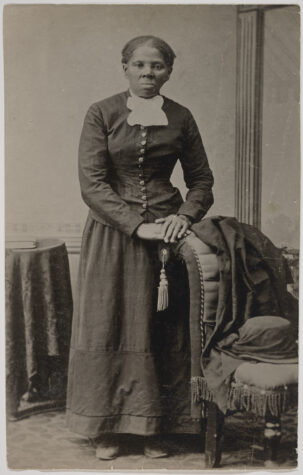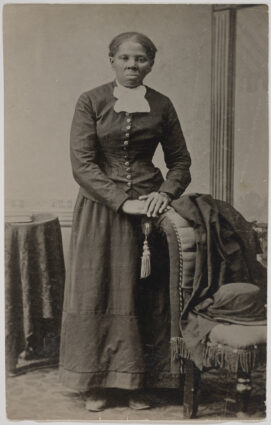
Harriet Tubman’s accomplishments in the abolition of slavery, the Civil War, and the women’s suffrage movement changed the arc of American history.
She was born Araminta “Minty” Ross to Harriet Green and Benjamin Ross sometime between 1820 and 1822 on a plantation in Dorchester County, Maryland. When she was five years old, Tubman’s owners rented her out to neighbors as a nursemaid where she was whipped whenever the baby cried. Two years later, she was rented out to set muskrat traps and later as a field hand.
Early signs of her resistance to slavery came at age twelve when she intervened to keep her master from throwing a heavy weight at a slave who tried to escape. When she stepped between them, the weight struck her. “The weight broke my skull… they carried me to the house, all bleeding and fainting. I had no bed, no place to lie down on at all, and they laid me on the seat of the loom, and I stayed there all day and the next.” She suffered from severe headaches and narcolepsy for the rest of her life.
Although it was illegal for slaves to marry, Tubman entered a marital union with John Tubman, a free black man, in 1844. She took his name and dubbed herself Harriet. The marriage was not good. In 1849, she and her two brothers escaped via the network of escape routes and safe houses known as the Underground Railroad. The brothers, however, changed their minds and went back. She continued north to Pennsylvania.
She returned to the South several times and helped at least seventy people gain their freedom as a “conductor” of the Underground, earning her the nickname “Moses of Her People.” Her success led slave owners to post a $40,000 reward for her capture or death. Tubman was never caught and never lost a “passenger.” The 1850 Fugitive Slave Act forced her to lead enslaved people further north to Canada, traveling at night, usually in the spring or fall, when the days were shorter. She often drugged babies and young children to prevent them from crying out. Tubman was active throughout the abolitionist movement and conspired with John Brown about raiding the Harpers Ferry federal arsenal, although she did not take part.
During the Civil War, she served as a scout, spy, guerrilla soldier, and nurse for the Union Army. Tubman often transformed herself into an aging woman and wandered the streets to discover Confederate Army supply lines and troop placements. As a nurse, Tubman dispensed herbal remedies to black and white soldiers dying from infection and disease. She is considered the first African American woman to serve in the military.
After the war, Tubman was active in the women’s suffrage movement. She married Nelson Davis and a few years later, the couple adopted a little girl named Gertie. In 1896, she purchased land next to her Auburn, New York home and opened the Harriet Tubman Home for Aged and Indigent Colored People. She supported her philanthropy efforts by selling her home-grown produce, raising pigs, and accepting donations and loans from friends. Tubman died of pneumonia on March 10, 1913 and was buried with military honors at Fort Hill Cemetery in Auburn, New York.
At just over five feet tall, Harriet Tubman was living proof that dynamite comes in small packages.
Photo credit: Lindsley, H. B., photographer. Portrait of Harriet Tubman. New York, None. [Auburn, n.y.: harvey lindsley, taken between 1871 and 1876?, printed between 1895 and 1910] [Photograph] Retrieved from the Library of Congress, https://www.loc.gov/item/2018645051/. Public domain.
